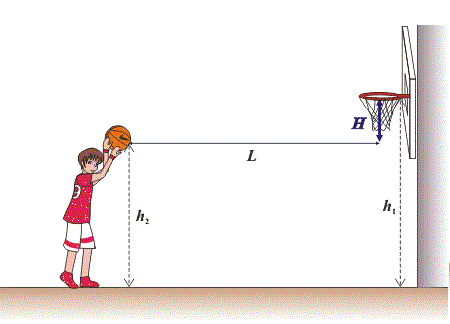Basketball player

'Not an original problem'. i felt that this is nice.so, i wanted to share it.
A basketball hoop is placed at a height above the floor. The centre of the basket is at a distance horizontally from the free-throw line. A basketball player shoots free throws and the ball leaves his hand in a moment where its centre is exactly above the free-throw line at a height above the floor.
The optimal elevation angle is an angle in which the centre of the ball passes through the hoop centre, while the minimal initial ball velocity is needed. Prove generally, that this angle is , where is the tangent angle, i.e. the deviation of a line connecting the hoop centre and the starting point of the shot from the horizontal plane.
Calculate the corresponding initial velocity of the ball (in ).
Details and Assumptions:
- Air resistance is negligible.
- , , ,
This section requires Javascript.
You are seeing this because something didn't load right. We suggest you, (a) try
refreshing the page, (b) enabling javascript if it is disabled on your browser and,
finally, (c)
loading the
non-javascript version of this page
. We're sorry about the hassle.
Consider the trajectory of the ball h 2 above ground. Let the initial velocity be v , elevation angle be θ , and h 1 − h 2 = h . Then the x and y displacements time t after shooting are given by x = v t cos θ and y = v t sin θ − 2 1 g t 2 . Substituting t = v cos θ x , we have y = x tan θ − 2 v 2 g x 2 sec 2 θ and the range D = g 2 v sin 2 θ .
For the ball passing through the centre of the basket, then the trajectory passes through the point ( L , h ) and
h tan β v g L 2 g L 2 d α d v = L tan α − 2 v 2 g L 2 sec 2 α = tan α − 2 v 2 g L sec 2 α = tan α − tan β sec α . . . ( 1 ) = 2 ( tan α − tan β ) 2 3 2 sec α tan α ( tan α − tan β ) − sec 3 α Since tan β = L h Rearranging d α d both sides
When v is minimum, d α d v = 0 , then we have
2 tan α ( tan α − tan β ) tan 2 α − 2 tan β tan α − 1 = sec 2 α = 1 + tan 2 α = 0
⟹ tan α ⟹ α = tan β + tan 2 β + 1 = tan β + sec β = 1 − tan 2 2 β 2 tan 2 β + 1 − tan 2 2 β 1 + tan 2 2 β = ( 1 + tan 2 β ) ( 1 − tan 2 β ) ( 1 + tan 2 β ) 2 = 1 − tan 2 β 1 + tan 2 β = tan ( 4 5 ∘ + 2 β ) = 4 5 ∘ + 2 β By half-angle tangent substitution
From ( 1 ) : v g L 2 = tan α − tan β sec α ⟹ v ≈ 7 . 7 .